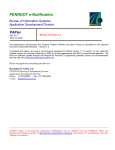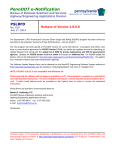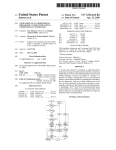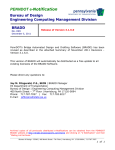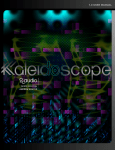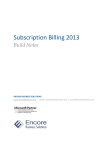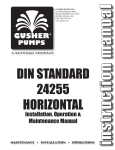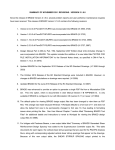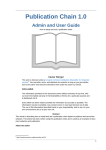Download 002 - PENNDOT LRFD and Engineering Programs
Transcript
COMMONWEALTH OF PENNSYLVANIA DEPARTMENT OF TRANSPORTATION www.dot.state.pa.us DATE: September 23, 2002 SUBJECT: LRFD Prestressed Concrete Girder Design and Rating PSLRFD Version 2.0 TO: District Engineer/Administrator Dist. 1-0, Dist. 2-0, Dist 3-0 Dist. 4-0, Dist. 5-0, Dist 6-0 Dist. 8-0, Dist. 9-0, Dist 10-0 Dist. 11-0, Dist. 12-0 Licensed Users of PSLRFD Program FROM: James W. Slaughter, Chief Information Systems Application Development Division The subject program has been revised as described on the attached Summary of August 2002 Revisions – Version 2.0. The User’s Manual has also been revised. For the Department’s use, PSLRFD Version 2.0 has been placed on each District’s File and Printer Server (S:\Engineering Unit\EngPrograms\ ProdVersion\PSLRFD). PSLRFD Version 2.0 will be available for use through the Engineering Dataset Manager (EngMgr) effective September 30, 2002. Each user should run “S:\Engineering Unit\EngPrograms\ Updates\ConfigFile.exe” to update the configuration files for PSLRFD on his/her PC before running the new version in EngMgr. The new User’s Manual in Acrobat PDF format can be found in the “C:\ProgramFiles\EngEditor\PSLRFD\Doc” folder or wherever the user installs and runs the configuration files for EngMgr. Consultants and others, who have a current license agreement for PSLRFD, can obtain the updated version by paying the license update fee. Since this program release includes major changes in design policy and many enhancements since the last release of version 1.4a in April 2000, the update license fee for this new version is set to $1,500 for private organizations and $100 for governmental agencies. The forms for Software Update Request and Request for PennDOT’s Engineering Software License can be downloaded from the web site at http://penndot.engrprograms.com. If you have any questions on this upgrade, please contact Hasmukh Lathia, P.E., of our Engineering Unit at (717) 783-8822. 330/RFY Attachments LRFD Prestressed Concrete Girder Design and Rating - PSLRFD Version 2.0 cc: Dean A. Schreiber, P.E., BOD, Keystone Building, 7th Floor R. Scott Christie, P.E., BQAD, Keystone Building, 7th Floor V. M. Patel, P.E., BQAD, Keystone Building, 7th Floor District Bridge Engineer, Dist.____ District IT Coordinator, Dist.____ Doug Tobin, P.E., ECMD, Keystone Building, 7th Floor Mike L. McKissick, P.E., CADD, Dist. 3-0 Earl W. Mellott, BIS Hasmukh M. Lathia, P.E., BIS LRFD PRESTRESSED CONCRETE GIRDER DESIGN AND RATING SUMMARY OF AUGUST 2002 REVISIONS - VERSION 2.0 Since the release of PSLRFD Version 1.4a several problem reports and user requested enhancements have been received. This release of PSLRFD Version 2.0 contains the following revisions and enhancements: 1. When calculating the DF2 moment distribution factor, the program now uses a weighted average for section properties that vary in adjacent spans. – (R154#3) 2. The word “Additional” was removed from the “Additional Stirrups Required for End Zone Bursting Stresses” output table heading. This was done to clarify that stirrups required for shear design and those required by the BD Standard can be included to satisfy bursting stress requirements. – (R154#4) 3. A footnote was added to the “Additional Stirrups Required for End Zone Bursting Stresses” output table to recommend a way to satisfy the bursting stress requirement when the required area of steel does not fit within the X(sr) distance. – (R154#5) 4. A 1.5% tolerance was added the minimum prestressing steel check. A code failure will only be reported when the ultimate moment capacity is exceeded by more than 1.5%. – (R154#6) 5. A new input parameter, “Slab Reinforcement Area per unit width”, was added to the SLB command. This parameter specifies longitudinal slab reinforcement outside the regions defined by the SST command. It is used compute the negative moment resistance. – (R154#8 and Request 024) 6. The lower limit for the “Stirrup Spacing” parameter for the STI command was changed from 2.5” (63mm) to 3” (75mm). In addition, the design stirrup spacing is limited to a minimum spacing of 3” (75mm). –R154#9) 7. When the tension in the longitudinal steel controls the shear design, a message is printed instructing the user to verify the slab reinforcement input. – (R154#11) 8. The Distribution Factor module was updated to include the DM-4 2000 revisions. – (Request 175) 9. The analysis module was updated to include changes from the Department’s Continuous Beam Analysis program, CBA Version 3.4. – (Request 176) 10. In previous versions, the program would abort when an interior diaphragm was entered using the DIA command for an I-beam. A revision was made that allows the program to continue running with a warning ignoring the interior diaphragm load. I-beams with interior diaphragms defined using the DLD or CLD i LRFD PRESTRESSED CONCRETE GIRDER DESIGN AND RATING commands are treated in the same manner. – (R154#16 and Request 129) 11. The future wearing surface moment is no longer included in the positive connection moment design. (Request 131) 12. The April 2000 DM-4 changes applicable to PSLRFD were implemented. Changes include a final net camber check for sag not greater than L/2000, an increased maximum prestressing force to 3000 kips (13,345 kN), setting the critical section for shear as the larger of 0.5 dv cot θ or dv, changing metric reinforcing steel grade from 400 to 420, and allowing the use of the oversized 0.52” (13.2 mm) diameter strands. – (Requests 162, 163, 177, 179, 181) 13. The governing HL93/PHL93 live load case for deflections is reported in the “Live Load Effects” output tables. (R154#19 and Request 185) 14. The factored effect reported in the “Factored Analysis Results” output table now correctly applies the minimum and maximum load factors for dead load, and correctly applies the load modifier for minimum and maximum effects. – (B153#1) 15. The debonded design procedure was revised to check initial compressive stresses at debonding transfer locations at both ends of the beam to avoid any stress problems related to slight variations in analysis results. Previously, stresses were only check for the left end of the beam assuming symmetric analysis results. – (T153#1) 16. For analysis runs, the negative moment resistance, reported in the "Negative Moment Capacity" output table, is computed based on the slab reinforcement as defined by SLB parameter 10, “Slab Reinforcement Area per unit width”, for analysis point outside the reinforcement range defined by the SST command. Previously, these resistances were reported as zero. – ( T153#2) 17. A problem causing different final losses to be used for symmetrical 2-span debonded design run was corrected. – ( T153#5) 18. The distribution factor applicability range violations for de is suppressed when the lever rule controls. Additionally, range violation warning messages are now printed with units. – (Requests 126, 127 and 140) 19. The distribution factor applicability ranges for the moment of inertia (I) and torsional constant (J) were extended to include standard plank sections. – (Request 136) 20. When the tension in the longitudinal steel controls the shear (actual longitudinal tension less than required tension), the shear rating is reduced by the ratio of the actual tensile resistance less the required dead load ii LRFD PRESTRESSED CONCRETE GIRDER DESIGN AND RATING resistance over the required live load resistance. – (Request 144) 21. The torsional constant (J) based on the composite section is printed for composite adjacent box beam. This is used to compute the distribution factor. Previously, the non-composite torsional constant was printed. – (Request 149) 22. The de distance, defined in AASHTO as the “distance from exterior web of exterior and the interior edge of curb or traffic barrier”, is now referenced from the centerline of the exterior web of the exterior beam instead of the exterior face of the web. – (Request 152) 23. When the distribution factor applicability range for de is violated for the without sidewalk case, the program will compute the distribution factor using both de and the violated limit, and then select the greater of the two distribution factors. – (Request 153) 24. The upper limit of the applicability range for de used when computing the exterior adjacent box beam shear distribution factor was corrected to be 600 mm instead of 610 mm.– (Request 164) 25. The skew correction factor is now applied to the I-beam distribution factor considering cross-frame action. – (Request 172) 26. An instance where asterisks, instead of the maximum spacing, were printed for stirrup spacing in “Shear Reinforcement and Resistance” output table for an analysis point that did not require stirrup was corrected. – (Request 173) 27. The 2000 DM-4 revised limits for beam spacing and span length applicability ranges were added. – (Request 175) 28. The defaults for the load modifiers (eta factors, CTL parameters 20, 21 and 22) were changed to 1.0. – (Request 184) 29. The User’s Manual was converted into PDF format. – (Request 186) 30. The use of several input parameters for the CDF command is explained in more detail in Section 6.8 of the User’s Manual. – (Request 190) 31. The program was revised to apply either the default 10% loss or the input “Estimated % P/S Loss” (MPS command) to the jacking force to compute the deflections due to prestressing. Previously, the program applied the loss to transfer prestressing force, which already includes the instantaneous loss. This change eliminates the directives set forth by Strike-off Letter 431-01-14. – (Request 195) iii LRFD PRESTRESSED CONCRETE GIRDER DESIGN AND RATING 32. The DM-4 Article 5.8.3.5 requirement that the area of longitudinal reinforcement for shear on the flexural tension side of the member need not exceed the area required to resist the maximum moment alone was implemented. This will correct instances where the stirrup spacings required by the program would decrease near the midspan. – (Request 196) 33. Strike-off Letter 431-01-07 revised DM-4 to require that the maximum dynamic load allowance (IM – live load impact) for the P-82 permit vehicle be reduced to 20% in accordance with a dynamic load study conducted for AASHTO by the Calibration Task Group. A new input parameter, “P-82 Dynamic Load Allowance”, with a default of 1.20 was added to the CTL command to satisfy the requirement. – (Request 197) 34. Camber calculations no longer include the deflection due to future wearing surface. – (Request 198) 35. The minimum and maximum live load rotations now reported as the negative most rotation and positive most rotation, respectively. – (Request 204) 36. The stress parameter, fpo, for shear design/analysis is taken as the stress in the prestressing strands with the assumption that the strands are fully developed at the transfer length in accordance with DM-4 Article 5.8.3.4.2. - (Request 212) 37. A convergence problem in the shear rating factor procedure has been corrected. - (Request 213) 38. The BDM command can now be used for a design run to enter a specific beam designation, enter a userdefined beam or override beam table dimensions. If the BDM command is used to design a user-defined beam (CTL command parameter “Beam Designation” is “U”), the SCD command must be used to define the available strand pattern. – (Requests 5, 7b, 12) 39. A problem that prevented strand patterns with zero-strand rows from being able to successfully design draped beams has been corrected. – (Request 7c) 40. An error message is printed after the Prestressing Data output tables and in the Specification Check Summary when the limit on total number of debonded strands is violated for an analysis run. – (Request 82) 41. There were a few instances in which a multi-span draped strand design run resulted in a successful design, but reported compressive stress code failures for Final DL+P/S load case near the supports. Since this problem can be corrected with crack control debonding, the prestressing force is reduced by 25% for analysis points within 3’ (900 mm) of the centerline of bearing for this stress check. – (Request 88) 42. In an attempt to reduce the volume of output, a new output option parameter was added to the CTL command. The default output option is to only print results at critical locations. Other output options are to print data for iv LRFD PRESTRESSED CONCRETE GIRDER DESIGN AND RATING th th 10 points plus critical locations or for 20 points plus critical locations. For shear-related output tables, 10th point results will also be printed for the critical point only output option. – (Request 100) 43. A zero can be entered for the “Span Number” parameter for the following commands to denote that the input applies to all spans: BDM, DIA, DBS, DPL, SCA, SCD, SPL, SSI, STI, and UDF. – (Request 101): 44. A zero can be entered for the “Support Number” parameter for the following commands to denote that the input applies to all supports: SKW and SST. – (Request 101): 45. A problem, which produces incorrect shears and moment due to diaphragm load at the diaphragm locations, was corrected. – (Request 102, 137) 46. The distances reported in all output tables are now locally referenced from the left support of the current span. Previously, some output tables used a global distance from the leftmost support of the entire structure. – (Request 104) 47. User-defined distribution factors for pedestrian live load are now correctly transposed to the right half of the structure when the symmetric option is used. This problem resulted unsymmetrical analysis result for a symmetrical structure. – (Request 130) 48. A problem resulting in unsymmetrical creep loads for a symmetrical structure has been corrected. – (Request 130) 49. The program was sometimes reporting unsymmetrical camber values for symmetric spans with debonded strands. This program malfunction has been corrected. – (Request 132) 50. The program was enhanced to allow input files to be in a different directory than program executable (Pslrfd.exe). – (Request 148) 51. The SCD command no longer supports the repeatability of parameters 1 through 7 so that two new input parameters could be added. This allows the user to override the design beam tables and enter user-defined strand limit per row. The “Number of Strands Rows at Midspan” and the “Number of Positions in Row I at Midspan” have been added to the SCD command. – (R154#15 and Requests 4, 7c) 52. In accordance with DM-4 Article 5.14.1.2.7a, the program has been enhanced to analyze multi-span structure as both continuously supported spans and simply supported spans for composite dead load and live load. When combining factored effects for the simple span check analysis option for a particular limit state, simple span analysis composite dead load effects are only combined with simple live load effects. Likewise, continuous composite dead load effects are only combined with continuous live load effects. – (Request 147) v LRFD PRESTRESSED CONCRETE GIRDER DESIGN AND RATING 53. For simple span check analysis option, both simple analysis and continuous analysis results are printed for composite dead loads. – (Request 147) 54. The sign convention for rotations used by PSLRFD is now the same as that used by the Continuous Beam Analysis (CBA) program. – (Request 147) 55. Output codes were added to the live load reactions and rotation to indicate whether the result is from the simple analysis or a continuous analysis for the simple span check analysis option. – (Request 147) 56. The MCA command parameters for creep and shrinkage allowable stresses are initialized properly when left blank so that the default values are assigned. – (Request 147) 57. A “Chief Bridge Engineer” warning message will be issued if the simple span check analysis option is not selected for multiple span bridges. This alerts users that DM-4 requires the simple span check be used expect in situation described in DM-4 Article 5.14.1.2.7a. – (Request 147) 58. For the simple span check analysis option, the following output reports will not be printed: Points of Contraflexure, Dead Load Creep and Shrinkage Moments, and Positive Moment Connection. These output tables do not apply when the simple span check analysis option is used. – (Request 147) 59. Another instance was found where data was not properly transposed to the right half of the structure when using the symmetry option resulting in an infinite loop. This has been corrected. – (Request 171) 60. The assumed default minimum area of deck steel in the negative moment region was increased from #4@12” to #4@12” top and #4@9” bottom for composite spread box beams and I-beams. – (Request 147) 61. The strand design procedure has been revised so that, when a beam is oversized due to depth difference requirement or user input minimum depth and the eccentricity cannot be obtained due strand pattern restraints, the program add strands before rejecting the beam. – (Request 147) 62. The program was revised to stop processing the final stress-check loop that was checking both the left and right drape points of a span (or transfer length locations of non-draped spans) if a failure occurred for the first location. If the loop was allowed to continue, the failure flag could be reset to successful while checking the second location. This resulted in code failures reported for an otherwise good design. – (Request 147) 63. The correct effective slab width use now used for the shear design to avoid a possible shear rating of less than 1.0. – (Request 147) 64. The “End Block Stresses” output table only prints stresses for non-debonded spans. – (Request 98) vi LRFD PRESTRESSED CONCRETE GIRDER DESIGN AND RATING 65. During the design process, spans that were entered as debonded can be changed to straight strands if debonding is not required for a particular beam size. When this occurred in previous versions of the program, the strand type was not reset to debonded when the beam was rejected and a new beam is tried. The program will now reset the strand type to debonded. – (Request 155) 66. The percentage, entered in “Percent Increase” parameter of the SLL command, is now correctly applied to the special live load. – (Request 156) 67. The “Special Axle Load” input summary output table correctly displays the input values when more than 7 axles are entered. Similarly, the “Span Lengths” input summary table correctly displays the input span lengths when more than 14 spans are entered. – (Request 158) 68. The file extension for the parameter definition file that contains various values for input parameters was changed from .pdf to .pd to avoid association with Adobe Acrobat files. – (Request 159) 69. Several possible conditions that could result in division by zero or a floating-point underflow message were addressed. – (Request 161) 70. Before exiting, the program will pause and require the user to press the enter key. This will allow the user to scroll back to view the runtime messages. – (Request 167) 71. Non-production versions of the program will have the text “ (TEST)” as part of the version number. – (Request 174) 72. Non-production versions of the program will print an additional beta test copyright notice. – (Request 168) 73. A problem, which caused the 1.2 Mcr requirement to never control the negative design moment for a solid section, was corrected. – (Request 146) 74. The correct span numbers are now printed at the transition from end of one span to the beginning of the next span. – (Request 145) 75. Section 3.7.17 Live Load Rotations was added to the User’s Manual to explain the different live load distribution used for rotations and deflection. – (Request 185) 76. The “Prestressing Data” output tables were moved closer to the beginning of the output after the input summary and before the section properties. – (Request 209) 77. A problem, where entering the same debonding length on multiple DBS command lines for the same span vii LRFD PRESTRESSED CONCRETE GIRDER DESIGN AND RATING resulted in an infinite loop during the debonding analysis, was corrected. - (Request 133) 78. The creep and shrinkage moments are now included in the negative moment steel design. – (Request 221) 79. The allowable tension stress with creep and shrinkage included, and the allowable slab compression stress are now reported in the "Allowable Concrete Stresses" output tables. – (Request 215) 80. For analysis runs, crack control debonded strands are excluded when checking the 25% total debonding limit. Additionally, crack control debonded strands are checked for the 50% total debonding limit. – (Request 216) 81. The headings of the "Prestress Values Based on Losses at Midspan of Simple Span" output table use the terminology "Effective" rather than "Final" to be consistant with the current AASHTO LRFD specification. – (Request 217) 82. The maximum allowable overhang for composite adjacent boxes was changed from 5"(125mm) to 8"(200mm). – (Request 223) viii










